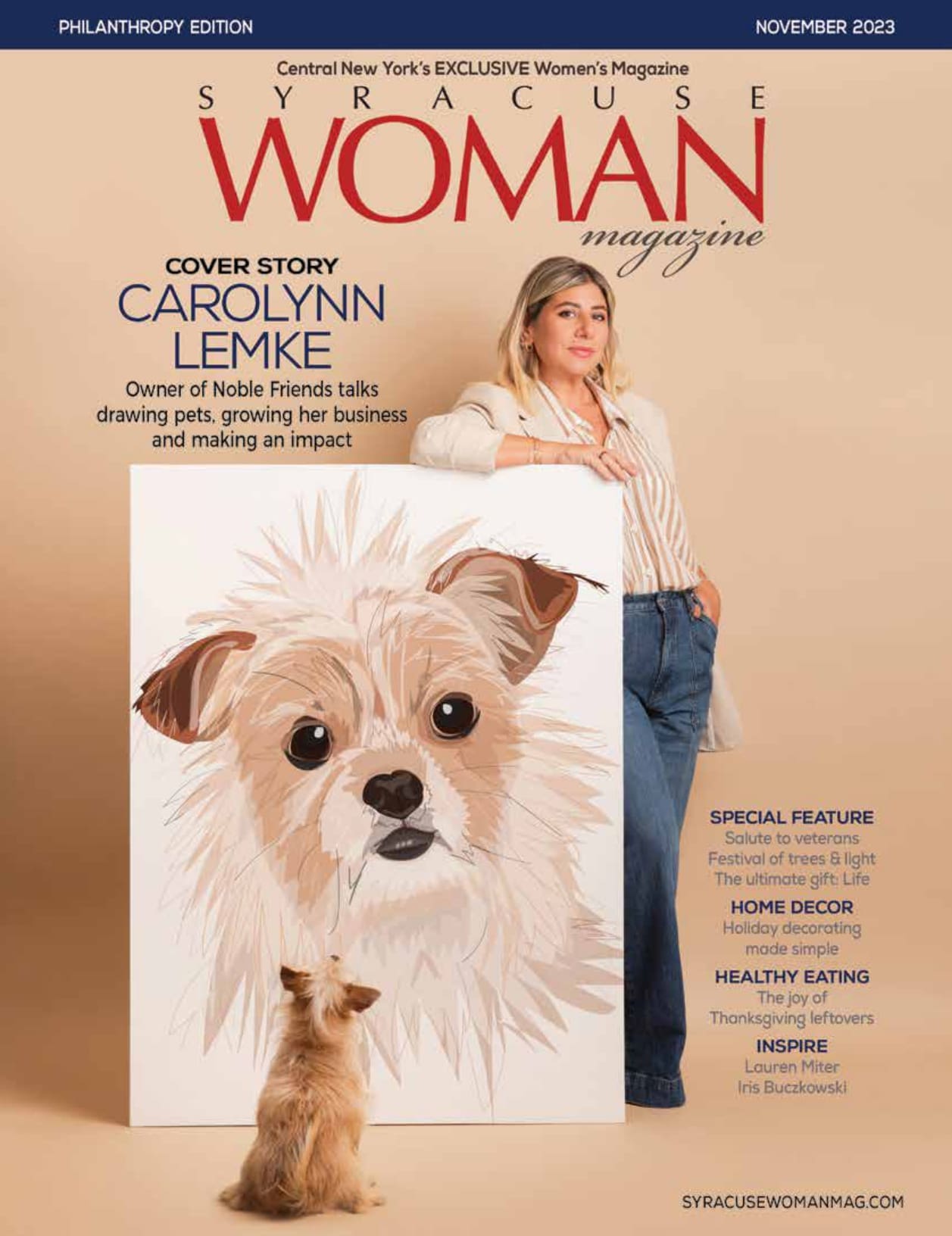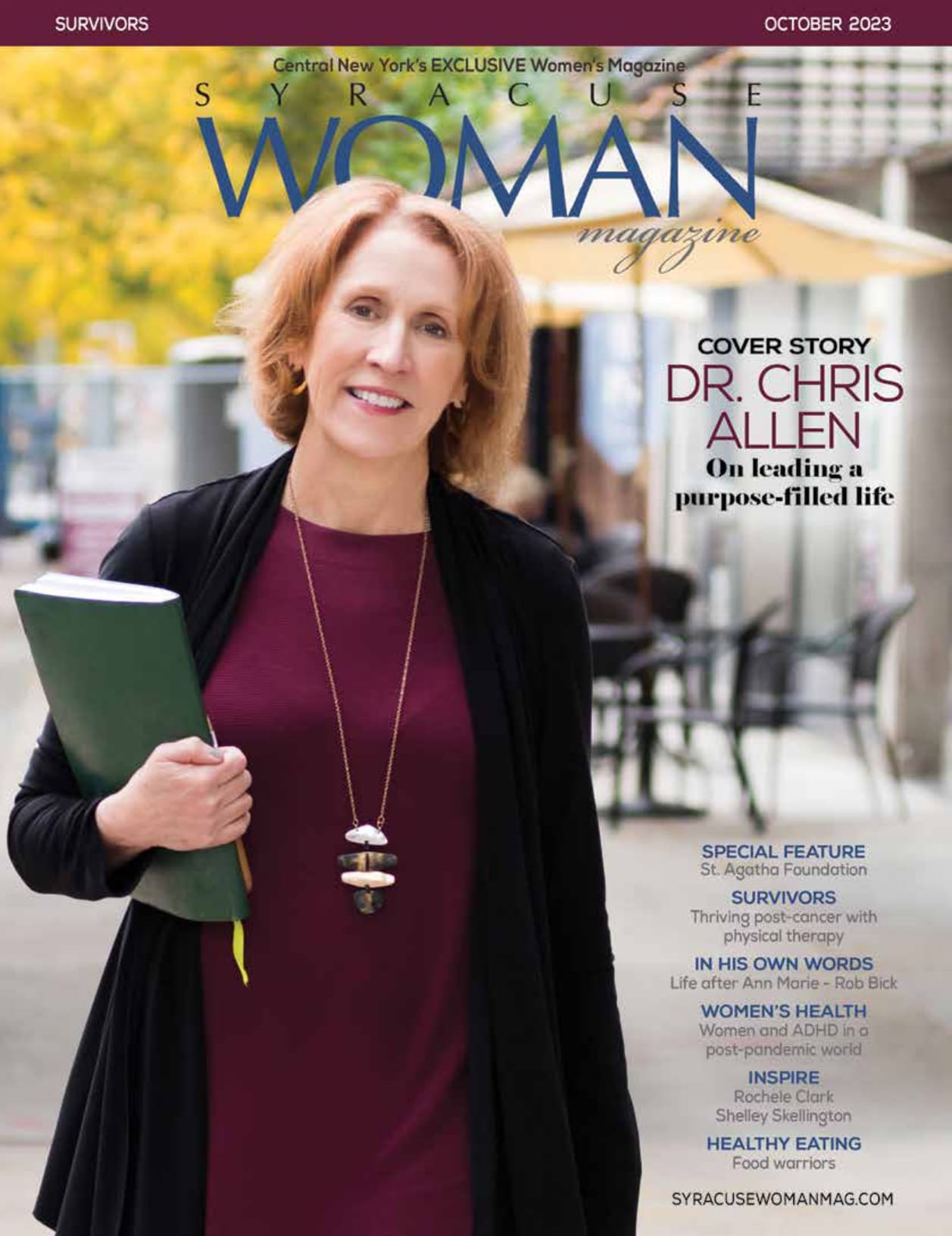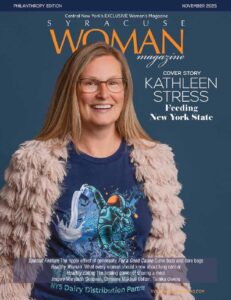By Lorna Oppedisano
Taylor Young Brown always knew she was meant to be a teacher. Even when she was living in New York City, pursuing musical theater and singing with a band, she spent her days in the classroom. Little did she know that her teaching journey would expand beyond guiding kindergartners to sharing her story of ovarian and breast cancer survival with her community and beyond.
Roots in Education
A Jamesville-DeWitt graduate, Taylor went on to study education in Rochester before moving to New York City and later Los Angeles.
“I love that I was able to do other things and learn about myself,” she said. But teaching was always her north star. “I realized that teaching was really my passion.”
When she eventually moved back to the area, she and her husband focused on raising their two children.
“They were much harder than my students,” she joked.
Once her youngest entered kindergarten, she returned to the classroom, teaching at Enders Road Elementary.
“I just love it. It’s me,” she said. “I feel like it’s where I’m meant to be.”
Double Diagnosis
Years later, as her oldest was preparing for college, Taylor began to notice troubling changes in her health. She described herself as someone deeply in tune with her body.
“It’s so important — it’s key — to listen to what your body is telling you,” she said.
In 2023, while teaching kindergarten, she recalled feeling “off” throughout the school year. She experienced bloating, stomach discomfort, and constant pain in her left side.
After visiting a gastroenterologist, tests revealed an ovarian cyst. Though she had experienced cysts before, this one was larger and more painful. Her gynecologist advised monitoring it, expecting it to dissolve on its own. When Taylor asked if the cyst could be removed with surgery, the doctor likened it to cutting off your finger to cure a paper cut.
“I want to advocate for women to not feel dismissed when you have pain,” she said. “It’s extremely important to stand up for yourself.”
Despite efforts to “tough it out” by doing things like cutting caffeine and monitoring her symptoms, the discomfort persisted.
“This is kind of a scary thing that I’m going to share, but I’ll say it,” Taylor shared. “I literally looked in the mirror and I was like, ‘I feel like I’m dying.’”
Trusting her intuition, she visited her former obstetrician, who discovered a large mass behind her uterus missed in earlier scans.
Taylor emphasized the value of knowing one’s baseline health.
“That’s what women should ask for,” she said. “So, when something doesn’t feel right, you can say, ‘Hey, you have the comparison and we can look at that now.’”
In August 2023, she was diagnosed with stage four ovarian cancer.
“I felt smushed into the ground and I couldn’t see straight,” Taylor remembered.
Thanks to a friend’s connection, she was transferred by ambulance from Syracuse to Dana-Farber in Massachusetts, where she received care from an all-women team — a comfort during an overwhelming time.
She began chemotherapy immediately to shrink the mass, completing six rounds, and then underwent surgery to remove the mass, as well as her ovaries, fallopian tubes, uterus, omentum and appendix.
“I lost all my hair, which was absolutely devastating for me. I had this long, long hair that I loved. Losing it was very traumatic,” she said. “At the same time, I was trying to be strong for my family.”
Further testing revealed she carried the BRCA-1 gene. Her parents were also tested. While she expected the gene to come from her mother’s side, it was her father who was the carrier. Thankfully, she shared, her brother — the father of three girls — was also tested and found he did not carry the gene.
“I am a perfect example that everyone should get genetic testing,” Taylor said. “I would have much rather been a pre-vivor than a survivor.”
Although doctors cleared her of ovarian cancer, a scan in May 2024 revealed a spot on her breast. Though she was assured that this would be nothing compared to what she’d been through fighting ovarian cancer, she remembered thinking that she was tapped out and couldn’t take any more.
“I’m still trying to be a mom,” she said. “I wanted to work, and I couldn’t work.”
She received the confirmation call during her son’s tennis match; it was breast cancer. After a lumpectomy in June 2024, she was relieved to learn it hadn’t spread. She then underwent 20 rounds of radiation that summer.
“I still face having a double mastectomy down the road. So, I still have more to come,” Taylor said. “That’s why I always say, if you can prevent this from happening with family members being tested, I think it’s extremely important.”
Looking to the Future
Taylor hopes to return to the classroom, this time to teach second grade, where her students will be a little more independent than those in kindergarten. She began preparing her room earlier this school year, but an abdominal obstruction forced her to pause her plans. This sort of complication comes with the territory after her previous major abdominal surgery, she shared. She now hopes to return later this year, a decision she’ll make with her doctors’ guidance.
She continues to receive blood transfusions every few weeks and is one year into a two-year cancer pill regimen. Another element important to Taylor’s recovery is pelvic floor therapy.
“All women deserve to have the tools to feel better after trauma to their body,” she said.
She credits her medical team with saving her life, and her husband, family and friends for helping her carry the weight of the past few years.
“You never know who might step up for you. It’s unbelievable, the amount of people that helped me,” Taylor said. “I would have never gotten to where I am. I wouldn’t be alive right now if it weren’t for the people and the connections that I have. I had so much love and care and people who stepped up.”
Regardless of when Taylor returns to the classroom, she’s going to continue teaching others about self advocacy.
“I like to try to put out information. I have shared my story. At first, I was private because I didn’t know how to deal with it all,” Taylor said. “But, once I processed things, I felt my story needed to be shared and people needed to hear it.”
Resources
American Cancer Society
American Cancer Society’s mission is to improve the lives of people with cancer and their families through advocacy, research, and patient support. For more information, visit cancer.org/about-us/local/new-york.html
BRCAStrong
BRCAStrong’s mission is to alleviate the emotional and financial burdens of women facing breast and/or gynecological cancer (regardless of genetic predisposition) through advocacy, direct assistance, empowerment and events. For more information, visit brcastrong.org/
Dana-Farber
Dana-Farber Cancer Institute provides expert, compassionate, and equitable care to children, adults, and their families, while advancing the understanding, diagnosis, treatment, cure, and prevention of cancer and related diseases. For more information, visit dana-farber.org.
Hope For Heather
Hope For Heather’s mission is to raise funds to support ovarian cancer research, to promote education and awareness, and to help to provide comfort to women and their families devastated by cancer. For more information, visit hopeforheather.org.








You must be logged in to post a comment.